Four Corners (Newark)
|
Four Corners Historic District | |
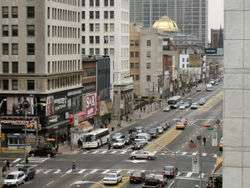 Looking south at Market and Broad with gold-domed Newark City Hall in distance | |
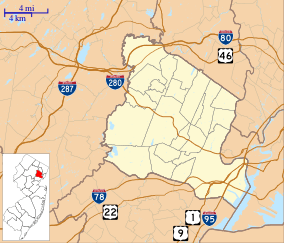 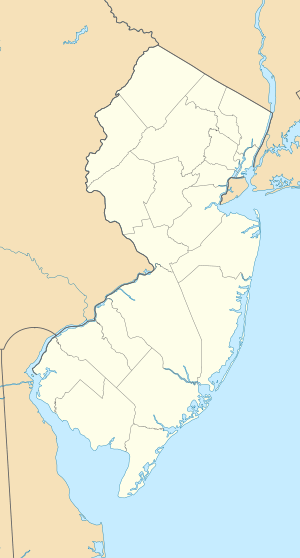 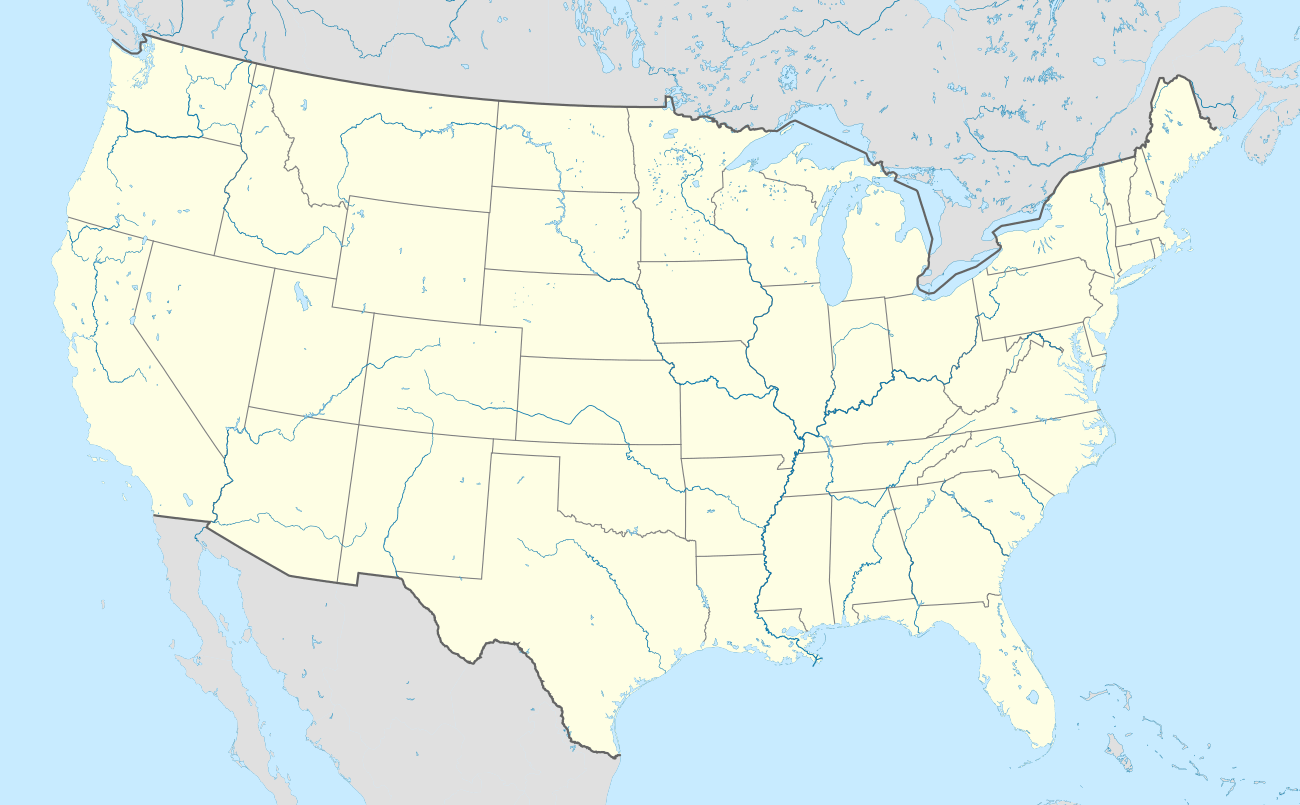 | |
| Location | Roughly bounded by Raymond Boulevard, Mulberry, Hill, and Washington Streets. |
|---|---|
| Coordinates | 40°44′08″N 74°10′20″W / 40.735560°N 74.172172°WCoordinates: 40°44′08″N 74°10′20″W / 40.735560°N 74.172172°W |
| Area | 85 acres (34 ha) |
| Architectural style | Renaissance, Italianate, 19th and 20th-century eclectic |
| NRHP reference # | 00001061[1] |
| NJRHP # | 126[2] |
| Significant dates | |
| Added to NRHP | September 8, 2000 |
| Designated NJRHP | November 18, 1999 |
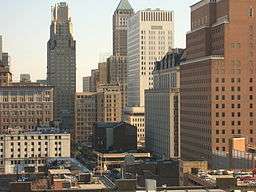
Four Corners at the intersection of Broad and Market Streets in Newark, Essex County, New Jersey, United States, is the site of the city's earliest settlement and the heart of Downtown that at one time was considered the busiest intersection in the United States.[3] A twenty-two-square-block area radiating from the crossroads is a state and federal historic district.[4]
The crossing became the center of the town soon after establishment in 1666;[5] the home of founder Robert Treat was located at the southwest corner.[6] During the next centuries it remained the focal point of the city which grew around it. By 1834 the United New Jersey Railroad and Canal Company had established a terminal to the south and in 1869 the Newark and New York Railroad had one to the north. During the period of massive expansion at the start of the 20th century, the district became the city's modern business district, and site of its first skyscraper built by the Firemen's Insurance Company at the southeast corner in 1910.[7][8] The Newark Public Service Terminal on Broad Street opened in 1916. Though faded in its former glory, the Four Corners district remains Newark's traditional center for commerce and business and since the late 2000s (decade) the focus of much interest in revitalizing retail, residential, and restaurant activity downtown.[9][10][11]
Broad and Market
The names and the crossing of streets named Broad and Market is seen in many of the colonial cities in New Jersey, such as Paterson and Trenton and the United States, such as Philadelphia. In Newark, Broad Street, as the name suggests, is a wide avenue which runs north to Military Park and Broad Street Station, while to the south it passes Government Center and Symphony Hall. Market Street to the east passes Gateway Center and Newark Penn Station, while to the west are the Essex County Courthouse and the many university campuses located in the city. It has long been a busy crossroad. In 1915, Public Service counted over 280,000 pedestrian crossings in one thirteen-hour period. Eleven years later, on October 26, 1926, a State Motor Vehicle Department check at the Four Corners counted 2,644 trolleys, 4,098 buses, 2,657 taxis, 3,474 commercial vehicles, and 23,571 automobiles.[12] Between 1925 and 1939 a manned 24-foot-tall (7.3 m) traffic control tower stood at the intersection.[13]
Historic district
The historic district is one of seven in Newark.[14] The Four Corners Historic District is roughly bounded by Raymond Boulevard, Mulberry Street, Hill, and Washington Streets and University Avenue. The district established in 1999–2000 encompasses an area of 85 acres (340,000 m2) and includes many buildings which themselves are listed on the national and state registers of historic places. The area is considered vital in the redevelopment of the city, located between city attractions, residential neighborhoods, educational and commercial institutions. In 2010, in order to promote the restoration of facades in the district the city has implemented stricter signage policy for any renovations.[15]
The northwest quadrant of the district has been home to Prudential Headquarters since its founding. Three buildings built by the finance company, including the Gibraltar Building on Halsey Street, are found there, as is the original flagship store of the department store Bamberger's.
The city's two tallest buildings, the neoclassical National Newark and Art Deco Eleven 80, are found in the northeast quadrant near the abutting historic district of Military Park.
The southeast quadrant is home to the Kinney Building, Old First Presbyterian Church, the First National State Bank Building, the Newark and New York Railroad terminal, and Newark City Hall at Government Center. The Prudential Center borders this section at Mulberry Street. A new hotel and retail complex at Broad and Lafayette Streets is also planned.[16][17][18] Several buildings in the southeast quadrant have been renovated for residential spaces.[19]
Teachers Village
In the southwest quadrant of the district some buildings, though more than 100 years old, are considered expendable in the greater development planning. To that end the demolition and replacement of some will lead to the creation of retail corridor between the Prudential Center and University Heights along Halsey Street.[20][21][22] The four-block-long project will be designed by native son Richard Meier and called Teachers Village.[23][24][25][26][27][28][29] Goldman Sachs committed $100 million to the project.[30]
Four Corners Millennium Project
In December 2012, the city council approved plans for further renovations in the district which would extend the neighborhood to Market Street that would rehabilitate former commercial buildings to residential and retail spaces. A similar proposal has been made for the former Newark Paramount movie palace.[31][32] In January 2014, the Four Corners Millennium Project was awarded $52 million in New Jersey State Economic Development grants.[33]
See also
References
- ↑ National Park Service (2009-03-13). "National Register Information System". National Register of Historic Places. National Park Service.
- ↑ "New Jersey and National Registers of Historic Places - Essex" (PDF). New Jersey Department of Environmental Protection - Historic Preservation Office. April 1, 2010. p. 10. Archived from the original (PDF) on March 27, 2009. Retrieved August 8, 2010.
- ↑ De Poto, Tom (December 19, 2012). "Newark developers to present plan to make historic Four Corners residential". The Star-Ledger. Retrieved July 5, 2013.
A project that would transform the intersection of Broad and Market streets — once known as the busiest cross streets in the nation — into a residential and retail neighborhood will go before Newark tonight for early approval.... At the dawn of the automotive age, the Four Corners was called the busiest intersection in the United States. A traffic study made on one day in 1926 tallied 36,596 vehicles, including taxi cabs, buses, passenger cars and 124 horse-drawn vehicles.
- ↑ "GET NJ - New Jersey - A Guide To Its Present And Past - Newark - Part 1". www.GetNJ.com. Retrieved October 26, 2017.
- ↑ http://lasur.epfl.ch/revue/A&C%20Vol%204%20No.2/GUBLER.pdf
- ↑ GmbH, Emporis. "Kinney Building, Newark - 121289 - EMPORIS". www.Emporis.com. Retrieved October 26, 2017.
- ↑ GmbH, Emporis. "Firemen's Insurance Building, Newark - 121311 - EMPORIS". www.Emporis.com. Retrieved October 26, 2017.
- ↑ "TALLEST BUILDING IN NEW JERSEY; Firemen's Insurance Co.'s New Home in Newark Will Be 205 Feet High" (PDF). New York Times. February 6, 1910. Retrieved July 29, 2010.
- ↑ "First Major Residential Conversion in 15 Years Rental for Downtown Newark". New York Times. March 3, 2001. Retrieved August 1, 2010.
- ↑ "Newark blueprint has lofty ambitions". June 2008. Retrieved August 1, 2010.
- ↑ Read, Philip (September 5, 2010). "Real estate broker revitalizes Newark's downtown landscape | NJ.com". The Star-Ledger. Newark. Retrieved October 26, 2017.
- ↑ Nieves, Evelyn (June 23, 1996). "Our Towns;At Crossroads, Space for Rent On 4 Corners". The New York Times.
- ↑ "The Four Corners Traffic Tower". www.OldNewark.com. Retrieved October 26, 2017.
- ↑ Newark landmarks website Archived 2008-02-22 at the Wayback Machine.
- ↑ "Newark's Downtown facades shed..." Newark Star=Ledger. January 2010. Retrieved 2010-08-08.
- ↑ http://www.ci.newark.nj.us/press/press_releases/2010_02_04_01.php
- ↑ "Newark gets first downtown hotel in 38 years". TheRealDeal.com. February 5, 2010. Retrieved October 26, 2017.
- ↑ Kaysen, Ronda (July 5, 2011). "Newark Is Building, With Help from Others". The New York Times.
- ↑ De Poyo, Tom (November 29, 2012). "A Place near the Rock" (PDF). The Star Ledger. Retrieved January 8, 2013.
- ↑ "A $150M, Richard Meier-Designed Village For Teachers? In Newark?! - Fast Company". FastCompany.com. May 29, 2012. Retrieved October 26, 2017.
- ↑ ""Teachers Village" project passes historic hurdle". The Star-Ledger. The Star Ledger. March 3, 2010. Retrieved August 8, 2010.
- ↑ "Villages grow in Newark — Joanne Jacobs". www.JoanneJacobs.com. Retrieved October 26, 2017.
- ↑ "Arts & Design". New York Times. May 5, 2010. Retrieved August 8, 2010.
- ↑ "Newark's teachers village: A promising development plan". NJ.com. Retrieved October 26, 2017.
- ↑ "Newark to break ground on long-awaited Teachers Village". NJ.com. Retrieved October 26, 2017.
- ↑ "RBH Group: Teachers Village New life for Newark". Business Experience. 2012-10-04. Retrieved 2012-02-12.
- ↑ "Beit credits EDA, Urban Transit Hub incentive at Newark groundbreaking - NJBIZ". NJBiz.com. Retrieved October 26, 2017.
- ↑ 10, Dana GoldsteinTwitter February; 2012 (February 10, 2012). "Cory Booker and Chris Christie: Teachers Should Live in Downtown Newark". TheNation.com. Retrieved October 26, 2017.
- ↑ "Teachers Village in Newark - NJ Building - e-architect". e-Architect.co.uk. February 15, 2012. Retrieved October 26, 2017.
- ↑ "Teachers Village". Urban Investments. Goldman Sachs. Retrieved 2013-01-26.
- ↑ De Poto, Tom (December 19, 2012). "Newark OKs early plan to revitalize the Four Corners downtown district". Retrieved December 20, 2012.
- ↑ "What will it take to make Newark a modern city?". NJ.com. Retrieved October 26, 2017.
- ↑ De Poto, Tom (January 15, 2014). "State awards $52 million in tax breaks for redevelopment at Newark's Four Corners". The Star-Ledger. Retrieved January 15, 2014.